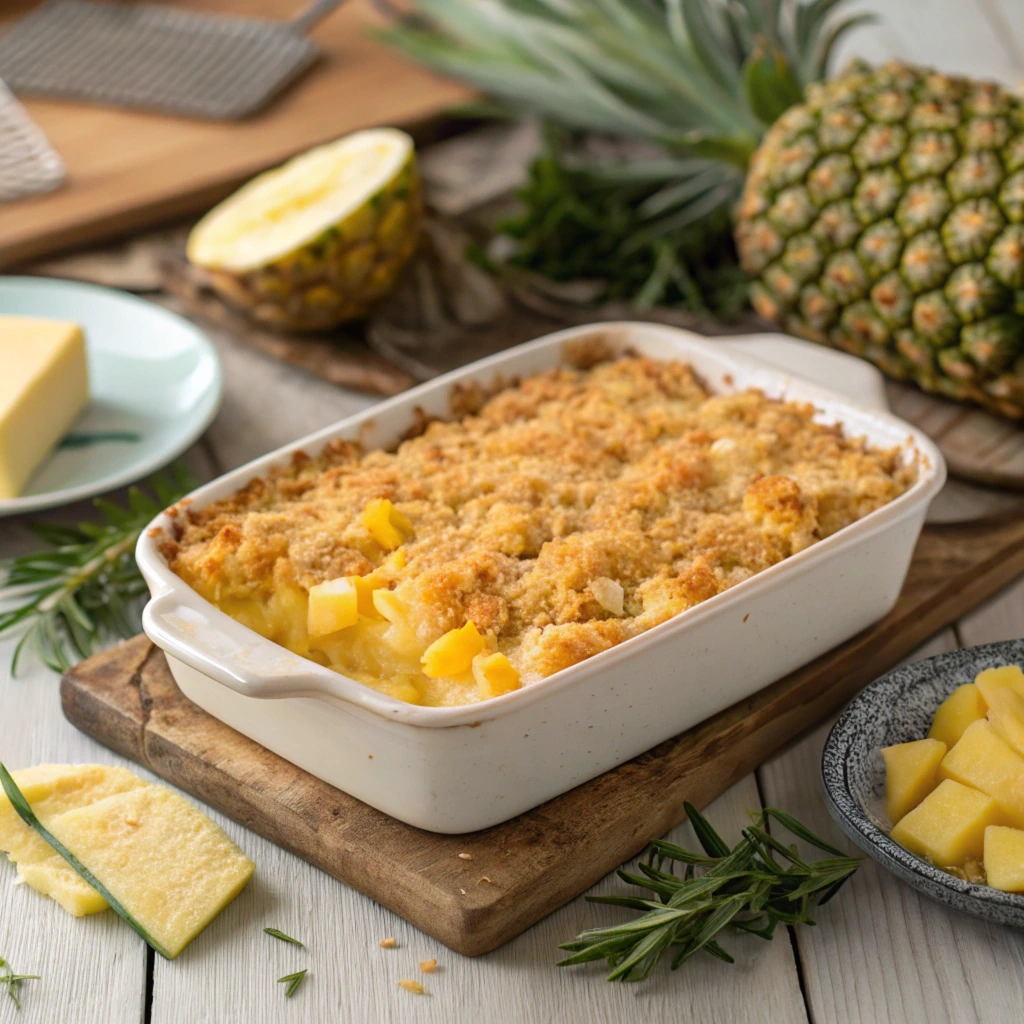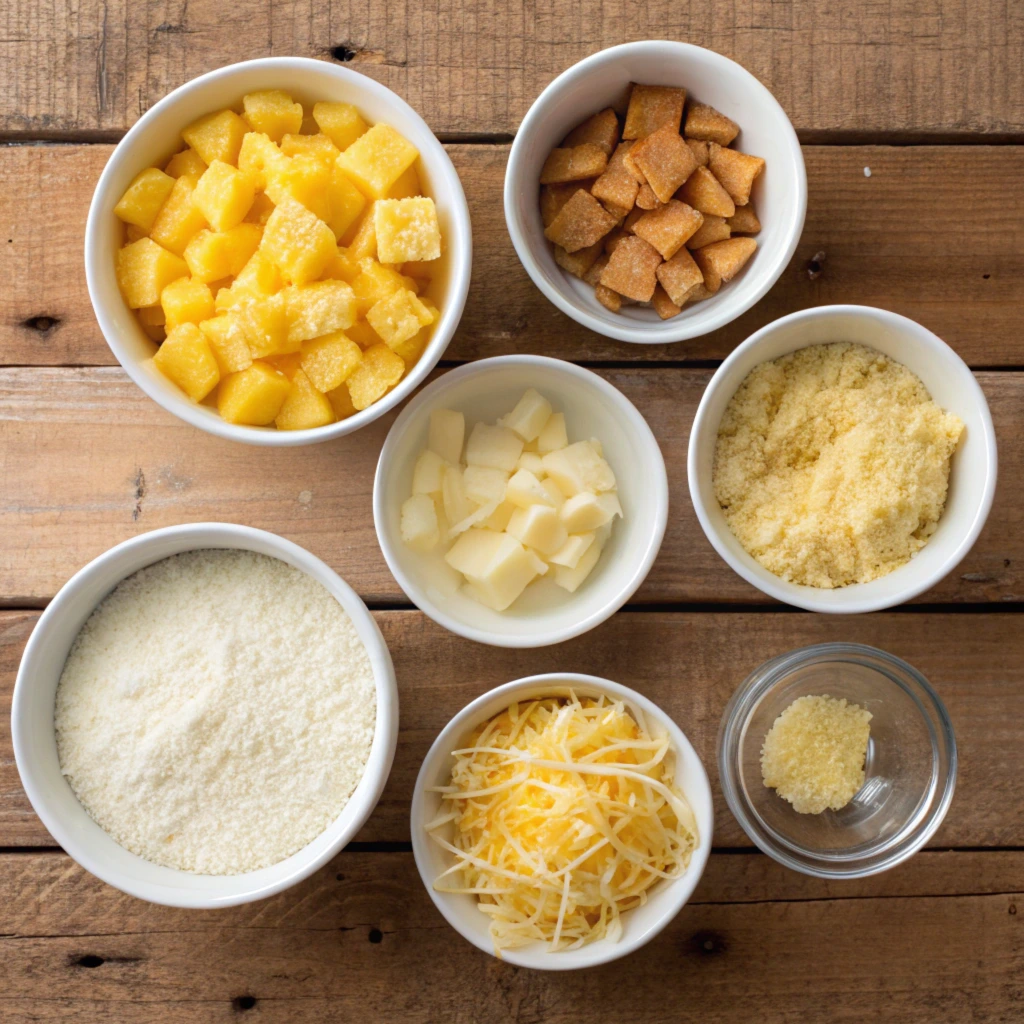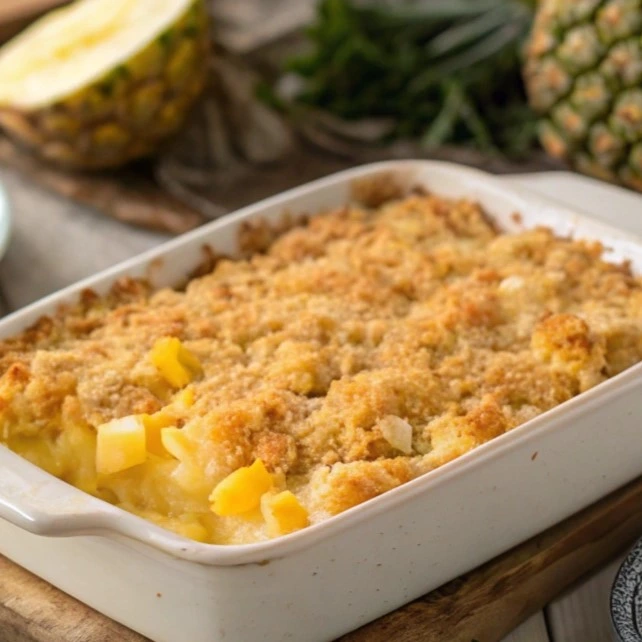When it comes to comfort food, casseroles are often the go-to choice for their ease and flexibility. Additionally, Sweet and savory combinations have always been crowd-pleasers, and one dish that perfectly blends these flavors is the pineapple casserole recipe.
Whether you’re hosting a family gathering or simply looking for a new dish to try, pineapple casserole is sure to impress. Its mix of juicy pineapple chunks, buttery crackers, and melted cheese creates a memorable culinary experience. In this guide, we’ll dive into everything you need to know about making the perfect pineapple casserole.

Introduction to Pineapple Casserole Recipe
Pineapple casserole is a Southern cuisine traditions that highlights the region’s love for surprising flavor combinations. While it may seem unusual to mix fruit with cheese and crackers, this dish has stood the test of time for a reason. The truth is, the pineapple casserole recipe is not only easy to make but also offers a delightful mix of sweet and salty flavors.
Typically, this dish is often served as a side dish, pairing well with ham or turkey during holiday meals. However, it’s just as suitable for a casual dinner or potluck. As a result, The combination of ingredients creates a texture that’s both creamy and crunchy, making every bite irresistible.
Whether you’re an experienced cook or just starting, this pineapple casserole recipe is easy and adjustable. It’s a great way to bring a tropical touch to your table. Let’s dive into what makes this dish so special.
Ingredients for the Perfect Pineapple Casserole Recipe

Before diving in, gathering the right ingredients is crucial. To ensure your pineapple casserole turns out perfectly balanced in flavor, use high-quality ingredients. Here’s what you’ll need:
Main Ingredients
- Pineapple chunks (canned or fresh): Aim for about two 20-ounce cans, drained.
- Sugar: 1 cup, for added sweetness.
- Flour: 6 tablespoons, to thicken the mixture.
Savory Components
- Cheddar cheese: 2 cups, shredded. Sharp cheddar works best for a bold flavor contrast.
- Ritz crackers: About 1 sleeve, crushed into crumbs.
- Butter: 1/2 cup, melted, to bind the topping.
Optional Additions
- Cinnamon or nutmeg: For a hint of spice.
- Chopped pecans: To enhance the crunchy texture.
By sticking to these key ingredients, you can ensure your pineapple casserole recipe delivers the right blend of sweet, savory, and creamy elements.
Step-by-Step Guide to Making a Pineapple Casserole Recipe
Preparing a pineapple casserole is both simple and satisfying. Follow these steps for a flawless dish:
1: Preheat the Oven
Set your oven to 350°F (175°C). This temperature is ideal for cooking the casserole evenly while allowing the topping to brown perfectly.
2: Prepare the Pineapple Base
- Drain the canned pineapple chunks thoroughly. Otherwise, Excess liquid can make the casserole too watery.
- In a large mixing bowl, combine the drained pineapple, sugar, and flour. Stir until the pineapple chunks are evenly coated.
3: Add the Cheese
- Fold in the shredded cheddar cheese. Since the sharpness of the cheese will balance the sweetness of the pineapple.
- Mix gently to ensure every bite includes both pineapple and cheese.
4: Assemble the Casserole
- Transfer the pineapple mixture into a greased 9×13-inch baking dish. Then, Spread it out evenly to ensure consistent cooking.
5: Create the Topping
- Crush the Ritz crackers into fine crumbs. A resealable plastic bag and rolling pin work well for this step.
- In a separate bowl, combine the cracker crumbs with melted butter. If desired, stir in chopped pecans for added crunch.
6: Layer the Topping
- Evenly sprinkle the cracker mixture over the pineapple base. The buttery topping will create a golden crust as it bakes.
7: Bake and Serve
- Bake the casserole for 25-30 minutes, or until the topping is golden brown and the filling is bubbling.
- Let the casserole cool for about 5 minutes before serving. This allows the flavors to meld together.
Tips for Perfecting Your Pineapple Casserole Recipe
Achieving the perfect pineapple casserole requires a few key tips and tricks:
- Drain the pineapple well: Excess moisture can ruin the consistency of the dish.
- Use fresh pineapple if possible: While canned pineapple is convenient, fresh fruit can add a brighter flavor.
- Adjust sweetness to taste: If you prefer a less sweet casserole, reduce the sugar slightly.
- Don’t skip the cheese: The combination of pineapple and cheddar is what makes this dish unique.
- Experiment with spices: Adding cinnamon or nutmeg can elevate the flavor profile.
By keeping these pointers in mind, your pineapple casserole recipe will turn out perfectly every time.
Why You’ll Love This Pineapple Casserole Recipe
The beauty of the pineapple casserole recipe lies in its versatility and simplicity. Here’s why it’s a must-try:
- Quick and Easy: With just a few steps, this dish comes together in under an hour.
- Crowd-Pleaser: Its unique flavor combination appeals to a wide range of palates.
- Perfect for Any Occasion: Whether it’s a holiday meal or a weeknight dinner, pineapple casserole fits the bill.
- Customizable: You can easily tweak the ingredients to suit your preferences.

Creative Variations of the Classic Pineapple Bake
Pineapple casserole is a classic dish that blends sweet and savory flavors seamlessly. While the traditional recipe is beloved, there are countless ways to add your twist to this family favorite. Below are some creative variations to elevate your pineapple casserole recipe:
- Cheesy Pineapple Casserole: Incorporate extra layers of sharp cheddar or a blend of cheeses like mozzarella and gouda for a richer texture. Cheese enhances the savory contrast to the pineapple’s sweetness.
- Tropical Twist: Add other fruits like mangoes or diced papaya alongside pineapple for a tropical burst of flavor. Sprinkle with toasted coconut flakes for added texture.
- Protein-packed Variation: Turn it into a hearty main course by including diced chicken, ham, or crumbled sausage. These proteins pair well with the sweetness of pineapple.
- Gluten-free Option: Swap traditional breadcrumbs for gluten-free crackers or almond flour. This ensures everyone at your table can enjoy the dish without compromising flavor.
- Spiced Pineapple Casserole: For those who love a kick, sprinkle a dash of cayenne pepper or chili flakes into the mix. The subtle heat balances the sweetness beautifully.
- Healthier Sweetener Alternatives: Replace white sugar with honey or maple syrup for a more natural sweetness. These alternatives provide a unique flavor depth.
- Crunchy Nut Topping: Enhance the texture by mixing crushed pecans, almonds, or walnuts into the topping. Nuts complement the casserole’s sweetness with a nutty richness.
Experimenting with these variations not only diversifies your meals but also makes your pineapple casserole recipe versatile enough for different occasions.
Nutritional Value of a Classic Pineapple Casserole Recipe
Understanding the nutritional components of your favorite dishes can help you make informed choices about what to include in your diet. The pineapple casserole recipe is no exception, offering both indulgent flavors and potential nutritional benefits.
Key Nutritional Highlights:
- Pineapple:
- Rich in vitamin C, which supports immune health and skin repair.
- Contains bromelain, an enzyme that aids digestion and has anti-inflammatory properties.
- Cheese:
- Provides a good source of calcium, essential for bone health.
- Offers protein, supporting muscle repair and growth.
- Bread or Cracker Topping:
- Supplies carbohydrates for energy but can be adjusted for dietary preferences, such as using whole-grain options for added fiber.
- Sugar and Butter:
- While these add indulgent sweetness and richness, moderation is key to balancing calorie intake.
Health-conscious Modifications:
- Swap refined sugar for natural sweeteners like stevia or agave syrup.
- Use reduced-fat cheese to lower calorie content.
- Incorporate whole-grain or gluten-free crumbs to increase fiber intake.
Although the traditional recipe leans toward comfort food, adjusting the ingredients ensures you can enjoy your pineapple casserole recipe without compromising on nutrition.
Learn more about pineapple’s health benefits to appreciate the added value it brings to this recipe.
Frequently Asked Questions About the Southern Pineapple Casserole (FAQs)
1. What kind of cheese pairs well with pineapple?
Pineapple’s sweet and tangy flavor pairs well with several types of cheese. For a balanced and flavorful combination, try sharp cheddar for its contrasting taste, mozzarella for its creamy mildness, or cream cheese for a smooth and tangy match. These combinations work beautifully in both sweet and savory dishes. For more pairing suggestions and tips, check out our guide: What Cheese Goes with Pineapple?.
2. Can canned pineapple be used instead of fresh?
Yes, canned pineapple is a convenient alternative to fresh pineapple in many recipes. While fresh pineapple provides a firmer texture and vibrant flavor, canned pineapple is softer and sweeter due to the syrup or juice it’s packed in. If you’re using canned pineapple for baking or cooking, drain it well to avoid excess liquid in your dish. To decide which option works best for your recipe, explore our detailed comparison: Fresh vs. Canned Pineapple.
3. What does pineapple do in baking?
Pineapple plays an essential role in baking by adding natural sweetness, a tropical tang, and moisture to cakes, muffins, and breads. Its high water content ensures baked goods stay soft and tender, while its natural acidity enhances leavening, making cakes lighter and fluffier when used with baking soda or powder. Pineapple also balances flavors beautifully, especially in desserts that combine sweet and tangy elements. Discover more about the magic of pineapple in baking by visiting: What Does Pineapple Do in Baking?.
4. Is it possible to make this dish dairy-free?
Yes, you can easily adapt a pineapple casserole recipe to make it dairy-free without sacrificing flavor. Start by substituting the regular cheese with a dairy-free alternative such as vegan cheddar or mozzarella. Many of these plant-based cheeses melt well and provide the creamy texture essential for this dish. For the buttery topping, replace the butter with a plant-based margarine or coconut oil. Additionally, check the labels of any crackers or breadcrumbs to ensure they are dairy-free. With these simple swaps, you can enjoy a delicious, dairy-free version of this classic dish that’s perfect for those with dietary restrictions.
5. How can I reduce the sweetness of the casserole?
If you find the traditional pineapple casserole recipe too sweet for your taste, there are several ways to adjust the sweetness to your preference. Start by reducing the amount of sugar in the recipe—cutting it by half can still achieve a balanced flavor. You can also use natural sweeteners like honey or maple syrup in smaller quantities to create a more subtle sweetness. Adding a pinch of salt to the mixture can enhance the savory elements and offset the sugar. Additionally, choosing pineapple packed in natural juice instead of syrup can help reduce the overall sweetness without altering the recipe too much.
Conclusion: Why the Pineapple Casserole Recipe Is a Must-Try
The pineapple casserole recipe is a versatile dish that blends the delightful sweetness of pineapple with rich and savory components, making it a crowd-pleaser for various occasions. Whether you stick to the classic recipe or explore creative variations, there’s no shortage of ways to enjoy this dish.
By understanding its nutritional value and addressing common questions, you can tailor the recipe to meet your dietary needs and preferences. Whether you’re preparing it as a comforting side or transforming it into a hearty main, pineapple casserole remains a timeless addition to your recipe repertoire.
Take the time to experiment, embrace substitutions, and share this delicious dish with loved ones. With endless possibilities, the pineapple casserole is more than just a recipe—it’s a culinary canvas.

